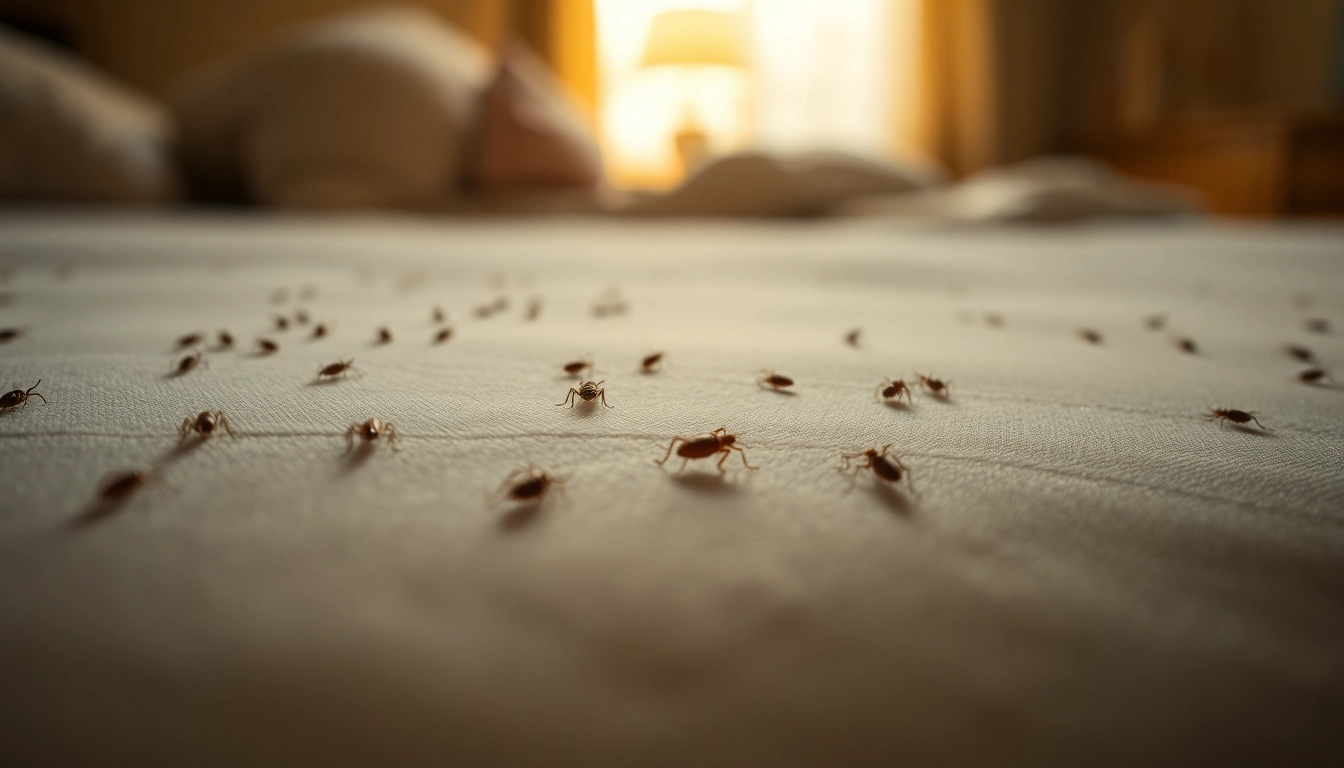Understanding Bed Bugs and Their Behavior
What are Bed Bugs?
Bed bugs, Cimex lectularius, are small, nocturnal insects that feed on the blood of humans and animals. These parasitic pests are approximately 4 to 5 millimeters in length and are often described as flat, oval, and brownish-red in color. They are commonly found in locations where people sleep, such as hotels, apartments, and homes. What makes bed bugs particularly troublesome is their ability to reproduce rapidly, create large infestations, and survive for months without feeding.
Common Signs of Infestation
Identifying a bed bug infestation promptly is crucial for effective control. Common signs include:
- Physical Sightings: Live bugs or shed exoskeletons found in bedding, mattresses, and furniture.
- Blood Stains: Small reddish-brown stains on sheets or mattresses from crushed bugs.
- Excrement Marks: Tiny black dots, resembling pepper, found on surfaces where bed bugs hide.
- Unpleasant Odor: A musty scent may be noticeable in severe infestations, caused by bed bug secretions.
The Life Cycle of Bed Bugs
Bed bugs undergo a series of life stages: egg, nymph, and adult. Females can lay up to 200 eggs in their lifetime, which typically hatch in about 7 to 10 days under optimal conditions.
Nymphs go through five molts, requiring a blood meal after each molt. This process can take several weeks to months based on environmental factors and food availability. Understanding this life cycle is essential for developing an effective bed bug control strategy.
Proven Methods for Bed Bug Control
Using Heat for Effective Elimination
Heat treatment is one of the most effective methods for bed bug eradication. This method involves increasing the temperature of the infested area to at least 115°F (46°C). This temperature is lethal to bed bugs and their eggs. Professional pest control companies often use specialized heating equipment to achieve these temperatures.
In addition to professional services, homeowners can use heat by washing bedding and clothing in hot water and drying them on high heat for at least 30 minutes. Vacuuming the areas where bed bugs are detected can also complement heat treatments by removing pests prior to heating.
Chemical Approaches: Safe Pesticides
Chemical treatments should be part of an integrated pest management (IPM) plan. Pesticides can kill bed bugs that are exposed to them, and there are several approved insecticides for this purpose. When using pesticides, it’s essential to follow the manufacturer’s instructions carefully, ensuring safety for both inhabitants and pets.
A common approach involves using a combination of residual sprays, which remain active long after application, and contact insecticides that kill on contact. Always consider alternative, less toxic options first, such as those containing diatomaceous earth.
Natural Remedies: What Works?
Natural solutions for bed bug control can be effective, especially when combined with other methods. Some common natural remedies include:
- Essential Oils: Oils like tea tree and lavender have insect-repelling properties.
- Diatomaceous Earth: This powdery substance can desiccate bed bugs, proving to be effective when applied in infested areas.
- Cold Treatments: Exposing bed bugs to extreme cold (below 0°F) for a specific duration can also eliminate them.
While natural remedies can help, it’s crucial to back them up with comprehensive cleaning and targeted approaches for best results.
DIY Bed Bug Control Techniques
Step-by-Step Guide for Homeowners
For homeowners looking to manage bed bugs independently, here is a detailed step-by-step guide:
- Inspection: Thoroughly check common hiding spots like mattresses, bed frames, and furniture.
- Declutter: Remove clutter that provides hiding spots for bed bugs. This includes old newspapers, clothes, and any unnecessary items.
- Heat Treatment: Wash all bedding and clothing on hot settings and dry on high heat as mentioned earlier.
- Vacuum: Vacuum the entire room extensively, sealing the vacuum bag in a plastic bag and disposing of it outside to prevent escape.
- Seal: Use mattress and box spring encasements designed to trap bed bugs inside, preventing them from feeding.
- Treat: Apply appropriate insecticides as necessary, focusing on cracks and crevices.
When to Call Professionals
While DIY strategies can be effective, there are instances where calling a professional pest control service becomes necessary:
- If the infestation is extensive and you have trouble managing it.
- When you are unable to locate the source of the infestation or if it persists despite your efforts.
- If you lack the time or resources to implement a comprehensive pest control strategy.
Budget-Friendly Control Options
Managing bed bugs doesn’t have to be overly expensive. Here are some budget-friendly options:
- Preventive Measures: Regular cleaning and vacuuming can drastically reduce the chances of infestation.
- DIY Solutions: Investing in a steamer and essential oils can be a cost-effective solution for treating bed bugs.
- Community Resources: Many local health departments offer resources or assistance for low-income households struggling with infestations.
Preventive Measures to Avoid Future Infestations
Maintaining a Clutter-Free Environment
One of the most effective ways to prevent bed bugs is to maintain a clean and clutter-free environment. Regularly decluttering your home, particularly in the bedroom, minimizes hiding spots for these pests. For college students or frequent travelers, avoiding clutter can also prevent bringing bed bugs back from stays in hotels or public transport.
Regular Cleaning and Inspections
Developing a regular cleaning schedule that includes frequent inspections can combat bed bugs effectively. Vacuuming with a focus on seams of mattresses, carpets, and furniture can disrupt potential infestations before they start. Additionally, incorporating washing bed linens frequently in hot water can aid in prevention.
Protecting Your Mattress with Encasements
Using mattress and pillow encasements specifically designed for bed bug protection is a proactive approach. These encasements prevent bed bugs from entering or escaping and provide a barrier that simplifies cleaning and detecting any bed bugs that might be present.
Resources and Further Reading on Bed Bug Control
Government and Health Guidelines
Numerous resources exist to assist homeowners in understanding and managing bed bug infestations. Websites such as the EPA’s bed bug resource page provide comprehensive guidelines for both prevention and control.
Online Forums and Support Groups
Engaging in online communities can provide support and shared experiences among those who are dealing with bed bug infestations. Websites like Reddit or specialized bed bug forums allow individuals to seek advice, share experiences, and learn from one another.
Expert Articles and Research Studies
Scientific research and articles offer valuable insights into the behavior and control of bed bugs. Many universities publish research-based findings online, providing evidence on the effectiveness of various treatment methods and the latest developments in pest control.






